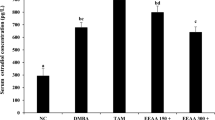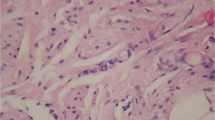Abstract
Tamoxifen, the widely prescribed drug in the prevention and therapy of breast cancer, may cause side effects which may be influenced by gender. The present study was undertaken to investigate the impact of gender on tamoxifen-induced toxic and biochemical changes following oral administration of tamoxifen at high dose level of 20 mg/kg once daily for a 2-week period in both male and female rats. The results showed marked increases in serum activities of alanine aminotransferase (ALT) and aspartate aminotransferase (AST) in female rats. In contrast, treatment with tamoxifen in male animals significantly decreased the activity of ALT, with a tendency for a decrease in serum AST levels. In female rats, a significant reduction in the serum activity of acid phosphatase (ACP) was noted, compared with a non-significant decrease in males. Non-significant changes in serum levels of alkaline phosphatase (ALP) were seen in both sexes. Tamoxifen lowered serum contents of total lipid and total cholesterol in both male and female rats. Serum levels of triglycerides were reduced in female rats as compared to a non-significant decrease in male animals. The serum albumin concentration was decreased in both male and female rats, while total protein was decreased only in female animals. Tamoxifen markedly increased serum levels of creatinine in female rats, compared with a non-significant rise in males. Total serum contents of calcium were similarly reduced in both males and females. This is the first study which points to gender-related differences in tamoxifen-induced toxic and metabolic changes in rats. The results indicated that females are more susceptible than males to tamoxifen toxicity, probably due to the ability of tamoxifen to antagonize the action of estrogen in females.
Similar content being viewed by others
References
Robinson E, Kimmick GG, Muss HB (1996) Tamoxifen in postmenopausal women a safety perspective. Drugs Aging 8:329–337
Jordan VC (1976) Antiestrogenic and antitumor properties of tamoxifen in laboratory animals. Cancer Treat Rep 60:1409–1419
Love RR, Newcomb PA, Wiebe DA, Surawicz TS, Jordan VC, Carbone PP, DeMets DL (1990) Effects of tamoxifen therapy on lipids and lipoprotein levels in postmenopausal patients with node-negative breast cancer. J Natl Cancer Inst 82:1327–1332
Floren LC, Hebert MF, Venook AP, Jordan VC, Cisneros A, Somberg KA (1998) Tamoxifen in liver disease: potential exacerbation of hepatic dysfunction. Ann Oncol 9:1123–1126
Williams GM, Iatropoulos MJ, Djordjevic MV, Kaltenberg OP (1993) The triphenylethylene drug tamoxifen is a strong liver carcinogen in the rat. Carcinogenesis 14:315–317
Fisher B, Costantino JP, Redmond CK, Fisher ER, Wickerham DL, Cronin WM, other NSABP contributors (1994) Endometrial cancer in tamoxifen-treated breast cancer patients: findings from the National Surgical Adjuvant Breast and Bowel Project (NSABP) B-14. J Natl Cancer Inst 86:527–537
Dnistrian AM, Schwartz MK, Greenberg EJ, Smith CA, Schwartz DC (1993) Effect of tamoxifen on serum cholesterol and lipoproteins during chemohormonal therapy. Clin Chim Acta 223:43–52
Thangaraju M, Kumar K, Gandhirajan R, Sachdanandam P (1994) Effect of tamoxifen on plasma lipids and lipoproteins in postmenopausal women with breast cancer. Cancer 73:659–663
de Medina P, Payre BL, Bernad J, Bosser I, Pipy B, Silvente-Poirot S, Favre G, Faye JC, Poirot M (2004) Tamoxifen is a potent inhibitor of cholesterol esterification and prevents the formation of foam cells. J Pharmacol Exp Ther 308:1165–1173
Colls BM, George PM (1998) Severe hypertriglyceridaemia and hypercholes-terolaemia associated with tamoxifen use. Clin Oncol (R Coll Radiol) 10:270–271
Murata Y, Ogawa Y, Saibara T, Nishioka A, Fujiwara Y, Fukumoto M, Inomata T, Enzan H, Onishi S, Yoshida S (2000) Unrecognized hepatic steatosis and non-alcoholic steatohepatitis in adjuvant tamoxifen for breast cancer patients. Oncol Rep 7:1299–1304
Oien KA, Moffat D, Curry GW, Dickson J, Habeshaw T, Mills PR, MacSween RPM (1999) Cirrhosis with steatohepatitis after adjuvant tamoxifen. Lancet 353:36–37
Xu JW, Gong J, Luo JY, Dong L, Hao Z-M, Jia A, Xu GP (2002) Estrogen reduces CCL4-induced liver fibrosis in rats. World J Gastroenterol 8:883–887
Pinzani M, Romanelli RG, Magli S (2001) Progression of fibrosis in chronic liver diseases: time to tally the score. J Hepatol 34:764–767
Yan JC, Ma JY, Pan BR, Ma LS (2001) Study of hepatitis B in China. Shi jie Hua Ren Xiao Hua Za Zhi 9:611–616
Hashiba M, Kasahara T, Kim SY, Shibutani S, Degawa M (2006) DNA damage and altered gene expression of enzymes for metabolism and DNA repair by tamoxifen and toremifene in the female rat liver. Cancer Sci 97:468–477
Reitman S, Frankel S (1957) A colorimetric method for determination of serum glutamic oxaloacetic and glutamic pyruvic transaminases. Am J Clin Pathol 28:56–63
Kind PRN, King EJ (1954) Estimation of plasma phosphatase by determination of hydrolysed phenol with amino-antipyrine. J Clin Pathol 7:322–326
Frings CS, Fendley TW, Dunn RT, Qeen CA (1972) Improved determination of total serum lipids by the sulfophosphovanillin reaction. Clin Chem 18:673–674
Allain CC, Poon LS, Chan CS, Richmond W, Fu PC (1974) Enzymatic determination of total serum cholesterol. Clin Chem 20:470–475
Bucolo G, David H (1973) Quantitative determination of serum triglycerides by the use of enzymes. Clin Chim 19:476–484
Doumas BT, Watson W, Biggs H (1971) Albumin standards and the measurements of serum albumin with bromocresol green. Clin Chem Acta 31:87–96
Gornall AC, Bardawill CJ, David MM (1949) A colorimetric method for determination of protein. J Biol Chem 177:751
Bartels H, Bohmer M (1971) Micro-determination of creatinine. Clin Chim Acta 32:81–85
Baginski ES, Marie SS, Clark WL, Zak B (1973) Direct microdetermination of serum calcium. Clin Chim Acta 46:49–54
El-Beshbishy HA (2005) Hepatoprotective effect of green tea (Camellia sinensis) extract against tamoxifen-induced liver injury in rats. J Biochem Mol Biol 38:563–570
El-Beshbishy HA (2005) The effect of dimethyl dimethoxy biphenyl dicarboxylate (DDB) against tamoxifen-induced liver injury in rats: DDB use is curative or protective. J Biochem Mol Biol 38:300–306
D’Mello D, Mehta D, Pereira J, Rao CV (1999) A toxicity study of simultaneous administration of tamoxifen and diazepam to female Wistar rats. Exp Toxicol Pathol 51:549–553
Czerny B, Juzyszyn Z, Myśliwiec Z (2003) Effects of tamoxifen and NaF on serum and hepatic enzymes. Fluoride 36:170–176
Subbiah MTR, Kessel B, Agrawal M, Rajan R, Abplanalp W, Rymaszewskii Z (1993) Antioxidant potential of specific estrogens on lipid peroxidation. J Clin Endocrinol Metab 77:1095–1097
Harada H, Pavlick KP, Hines IN, Hoffman JM, Bharwani S, Gray L, Wolf RE, Grisham MB (2001) Selected contribution: effects of gender on reduced-size liver ischemia and reperfusion injury. J Appl Physiol 91:2816–2822
Lui Q-H, Li D-G, Huang X, Zong C-H, Xu Q-F, Lu H-M (2004) Suppressive effects of 17β-estradiol on hepatic fibrosis in CCl4-induced rat model. World J Gastroenterol 10:1315–1320
Nuwaysir EF, Dragan YP, Jefcoate CR, Jordan VC, Pitot HC (1995) Effects of tamoxifen administration on the expression of xenobiotic metabolizing enzymes in rat liver. Cancer Res 55:1780–1786
Davis W, Hewer A, Rajkowski KM, Meinl W, Glatt H, Phillips DH (2000) Sex differences in the activation of tamoxifen to DNA binding species in rat liver in vivo and in rat hepatocytes in vitro: role of sulfotransferase induction. Cancer Res 60:2887–2891
Dehal SS, Kupfer D (1999) Cytochrome P-450 3A and 2D6 catalyze ortho hydroxylation of 4-hydroxytamoxifen and 3-hydroxytamoxifen (droloxifene) yielding tamoxifen catechol: involvement of catechols in covalent binding to hepatic proteins. Drug Metab Dispos 27:681–688
Brown AP, Morrissey RL, Crowell JA, Levine BS (1999) Difluoromethylornithine in combination with tamoxifen in female rats: -13 week oral toxicity study. Cancer Chemother Pharmacol 44:475–483
Thangaraju M, Rameshbabu J, Vasavi H, Hanchezhian S, Vinitha R, Sachdanandam P (1998) The salubrious effect of tamoxifen on serum marker enzymes, glycoproteins, and lysosomal enzymes levels in breast cancer women. Mol Cell Biochem 185:85–94
Altan N, Chen Y, Schindler M, Simon SM (1999) Tamoxifen inhibits acidification in cells independent of the estrogen receptor. Proc Natl Acad Sci USA (Cell Biology) 96:4432–4437
Gold E, Stapley S, Goulding A (1994) Tamoxifen and norethisterone: effects on plasma cholesterol and total body calcium content in the estrogen-deficient rat. Horm Metab Res 26:100–103
Kenny AM, Prestwood KM, Pilbeam CC, Raisz LG (1995) The short term effects of tamoxifen on bone turnover in older women. J Clin Endocrinol Metab 80:3287–3291
Reckless J, Metcalfe JC, Grainger DJ (1997) Tamoxifen decreases cholesterol sevenfold and abolishes lipid lesion development in apolipoprotein E knockout mice. Circulation 95:1542–1548
Wade GN, Heller HW (1993) Tamoxifen mimics the effects of estradiol on food intake, body weight and body composition in rats. Am J Physiol 264:R1392–R1398
Vinitha R, Thangaraju M, Sachdanandam P (1997) Effect of tamoxifen on lipids and lipid metabolising marker enzymes in experimental atherosclerosis in Wistar rats. Mol Cell Biochem 168:13–19
Ickenstein LM, Bandiera SM (2002) Persistent suppression of hepatic CYP2A1 expression and serum triiodothyronine levels by tamoxifen in intact female rats: dose-response analysis and comparison with 4-hydroxytamoxifen, fulvestrant (ICI 182,780), and 17β-estradiol-3-benzoate. J Pharmacol Exp Ther 302:584–593
Hozumi Y, Hakamata Y, Nagai H (2005) Plasma leptin concentration in tamoxifen-treated ovariectomized rats. Gynecol Obstet Invest 59:70–74
Li D, Dragan Y, Jordan VC, Wang M, Pitot HC (1997) Effects of chronic administration of tamoxifen and toremifene on DNA adducts in rat liver, kidney, and uterus. Cancer Res 57:1438–1441
Schild LJ, Divi RL, Beland FA, Churchwell MI, Doerge DR, Gamboa da Costa G, Marques MM, Poirier MC (2003) Formation of tamoxifen-DNA adducts in multiple organs of adult female cynomolgus monkeys dosed with tamoxifen for 30 days. Cancer Res 63:5999–6003
Kang D-H, Yu ES, Yoon K, Johnson R (2004) The impact of gender on progression of renal disease - Potential role of estrogen-mediated vascular endothelial growth factor regulation and vascular protection. Am J Pathol 164:679–688
Stringer KD, Komers R, Osman SA, Oyama TT, Lindsley JN, Anderson S (2005) Gender hormones and the progression of experimental polycystic kidney disease. Kidney Int 68:1729–1739
Author information
Authors and Affiliations
Corresponding author
Rights and permissions
About this article
Cite this article
Hemieda, F.AK.ES. Influence of gender on tamoxifen-induced biochemical changes in serum of rats. Mol Cell Biochem 301, 137–142 (2007). https://doi.org/10.1007/s11010-006-9405-2
Received:
Accepted:
Published:
Issue Date:
DOI: https://doi.org/10.1007/s11010-006-9405-2




